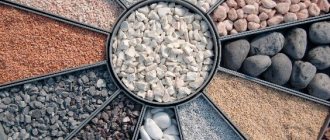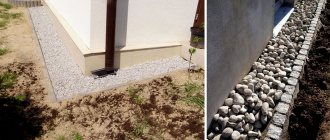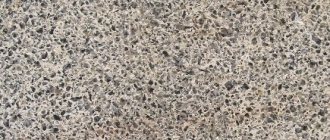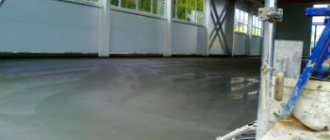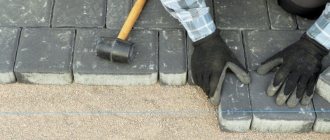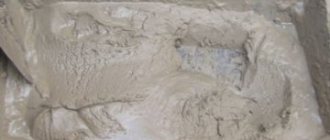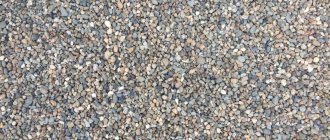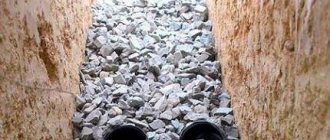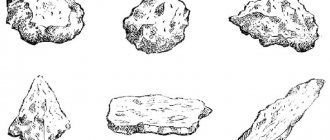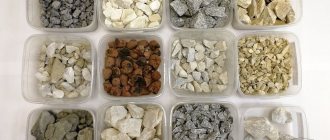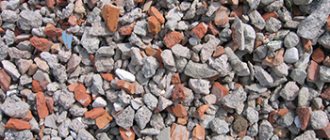August 1, 2020 Stroyexpert Home page » Foundation » Materials and equipment
Crushed stone for the foundation
The foundation is the main and very important part of the structure, so the preparation of the mixture for pouring it should be approached with great responsibility. Particular attention should be paid to the ingredients included in the concrete solution, in particular crushed stone. It is this building material that determines the strength of the concrete mixture. Therefore, it is necessary to study the properties of crushed stone and its quality characteristics.
Classification and main characteristics of crushed stone
Crushed stone is an artificial bulk material that is obtained by grinding individual rocks or slag - waste from the construction and metallurgical industries. The material of manufacture affects not only the class of the resulting crushed stone, but also its characteristics.
Depending on the source raw material, crushed stone has the following classification:
- Crushed granite is obtained by crushing rocks such as basalt, granite or dolomite. This is the most durable building material.
- Crushed gravel can be of two types: crushed, obtained by crushing rocks, or natural, which is gravel from the sea or river bottom, which has a rounded shape. The main use of this type of crushed stone is to create a cushion for a foundation or blind area.
- Limestone crushed stone is the weakest material in terms of strength, therefore it is used in arranging drainage systems or for preparing concrete mortar for pouring blind areas.
- Slag crushed stone is a product of processing metallurgy slag. It is a high-strength material, so it can be used as a filler for concrete.
- Recycled crushed stone is obtained by crushing construction waste. The strength of this material is at an average level, so it can be used in the construction of foundations for low-rise structures.
In addition, crushed stone is divided into classes according to other criteria:
- Fraction size. Crushed stone for construction can be of two types: 5-25 mm and 26-60 mm.
- Temperature resistance or frost resistance. This indicator determines how many freezing and thawing cycles the material will withstand without losing its basic characteristics. Granite crushed stone has the best indicator; it can withstand 300 cycles. The lowest is for crushed limestone; it retains its properties only for 150 cycles.
- Flakiness. This criterion determines the presence of flat particles in the total volume of the material. In this regard, crushed stone can be cube-shaped, needle-shaped and lamellar. To build a foundation, it is better to use crushed stone with the least number of flat elements. Crushed stone in the form of cubes fills the concrete more densely, reducing the risk of voids. Other types of crushed stone can be used to create a sealing pad under the base.
- Radioactivity.
This indicator is a very important characteristic, therefore, when purchasing crushed stone, you must ask the seller for quality certificates for the material.
For the construction of the foundation, it is allowed to use crushed stone of the first class of radioactivity.
Choosing crushed stone for building a foundation
Crushed stone is one of the main components of the concrete mixture used to pour the foundation. Thanks to its presence, the creep of freshly prepared mass decreases and the strength and elasticity of concrete increases. When deciding what kind of crushed stone is needed for the foundation, the characteristics of the given building material, as well as the type of structure being built, are taken into account.
Types of crushed stone
The starting materials for production are gravel, boulders and rocks. Depending on its origin it is divided into:
1. Granite. It is mined from hard rock - granite, consisting of clearly formed crystals of quartz, mica and feldspar, and has gray, pink and red hues. Crushed stone is obtained by crushing blocks and further sifting by size, while granite is considered the best material for its production.
2. Limestone. It is a product of crushing common sedimentary rock, in which calcite predominates. This type is also called dolomite.
3. Gravel. It is produced by either crushing large blocks of natural sedimentary rock or the less traditional method of sifting quarry rock. This also includes the gravel itself, which is formed from loose river and sea rocks.
Crushed stone produced by crushing or sifting has the same parameters as granite, but gravel has a round or ovoid grain shape. The absence of sharp corners reduces the adhesion of the concrete solution, so this building material is not suitable for preparing concrete. The best place to use gravel is under the foundation.
Characteristics and brands
The main characteristics of the above types include indicators such as radioactivity, frost resistance, strength, flakiness and fraction.
1. Radioactivity.
Some varieties have background radiation. This is explained by the fact that rocks (mainly granite) contain radionuclides of natural origin - thorium, cesium, uranium and others. In most cases, the radiation is so small that there is no reason to worry about it.
Crushed stone for foundations that goes on sale must have a certificate of conformity indicating the radioactivity category in Bq/kg (becquerel per kilogram). This building material with an index of less than 370 Bq/kg is considered suitable for the construction of foundations for residential and public buildings, and for non-residential buildings – 740 Bq/kg and higher. It should be noted that only natural gravel does not have radioactivity.
2. Frost resistance.
To determine this indicator, crushed stone is subjected to freezing and thawing. Made from granite, it has a frost resistance of F300-F400, limestone - from F25 to F100, and gravel - from F15 to F200. For the foundation of a residential building you need crushed stone with a parameter of at least F300.
3. Strength (grade).
Strength is determined by its compression, crushing, and wear in the drum. This simulates the impact of moving vehicles and rollers compacting the road surface. As a result of testing, crushed stone is assigned the following grades:
- high-strength – M1200, M1400;
- durable - from M800 to M1200;
- medium strength - M600, M800;
- low strength - from M300 to M600;
- very weak strength - M200.
To fill the foundation for a residential building, M1200 crushed stone is needed, and in order to build a foundation for a fence, M600 or M800 is sufficient.
4. Flakiness.
The shape of the grains plays a more important role than the material from which they are obtained. The most ideal is considered to be cuboid, but the presence of flat and oblong pebbles, called “flaky”, is undesirable. Based on their percentage in the total mass, the group is determined:
- 1 – less than 10%;
- 2 – from 10% to 15%;
- 3 – from 15% to 25%;
- 4 – from 25% to 35%;
- 5 – from 35% to 50%.
When compacting concrete, the batch of which is made from highly flakier crushed stone, voids are formed. For this reason, the material for the foundation of the house should be 1 or 2 groups. If you reduce the volume of intergranular voids in concrete to a minimum, this will lead to significant savings in cement.
5. Crushed stone fraction.
This is the average size of its grains. In construction, crushed stone with an index of 5 to 25 mm and from 26 to 60 mm is used, and for pouring the foundation - 5-10 mm, 10-20 mm and 20-40 mm.
Tips and tricks for choosing
When constructing a foundation for any building, you should pay attention to some points related to the specifics of choice and use.
1. In the case of building a heavy and large house, its foundation must be strong, which means crushed granite stone with high characteristics is needed. For the foundation of a barn, garage, fence, veranda or gazebo, limestone is sufficient, which is sold at a more affordable price.
2. If the work is done manually, then the use of large fractions will significantly complicate it, not to mention the fact that the quality of the concrete mixture will not meet the standard. Here you need a stone no larger than 20 mm.
3. With small cells of the reinforcing frame, working with a concrete mass mixed with large crushed stone is difficult. The same applies to pouring concrete into piles, where air voids can only be avoided if the finest fraction is used.
4. When buying crushed stone, you should pay attention to the quality of the grains. If they have defects such as peeling and cracks, then they will not be suitable for constructing a foundation for a house. Here you need cuboid granite.
Estimated cost
Price formation is influenced by such indicators as type, fraction and volume of purchases. The table shows the average cost in rubles, subject to pickup or delivery in Moscow:
| Fraction (size), mm View | Pickup | With delivery throughout Moscow | |||||||
| Price, rubles/ton | |||||||||
| 40-70 | 25-60 | 20-40 | 5-20 | 70-120 | 40-70 | 25-60 | 20-40 | 5-20 | |
| Granite | 1450 | 1500 | 1550 | 1600 | 2100 | 1800 | 1800 | 1900 | 2000 |
| Limestone | 1000 | — | 1100 | 1150 | — | 1250 | — | 1250 | 1300 |
| Gravel | 1250 | — | 1300 | 1450 | — | 1500 | — | 1600 | 1600 |
| Crushed stone in bags | 130 rubles/piece (packed in 50 kg) | ||||||||
The influence of crushed stone fraction on the quality of the foundation
The crushed stone fraction is usually understood as a collection of particles of approximately the same size. Crushed stone makes up the main part of the concrete solution, therefore, the quality of the foundation completely depends on its characteristics. Crushed stone in concrete minimizes the shrinkage process, increases strength characteristics, density and makes the foundation more resistant to cracking.
Fractionality of crushed stone
The strength of the foundation largely depends on the strength of the concrete. This indicator is greatly influenced by the density of the concrete being mixed. To reduce the number of voids in the concrete solution, you need to choose the right size of crushed stone and sand. The optimal composition involves the use of crushed stone and large and small fractions, so that the voids between large elements can be filled with small particles.
Concrete components
Concrete is a mixture of three materials: a special filler, cement and water.
In addition to crushed stone, cement, sand and water, special additives can be included in concrete
The filler is usually crushed stone or gravel and sand. Any of these materials serves as a stone skeleton composed of mineral elements. The special filler in the concrete is entrusted with a special mission - to strengthen the load-bearing capacity of the foundation being constructed. The solution for pouring the base consists of 80% crushed stone and sand.
Broken bricks cannot be added to the mixture along with sand and crushed stone. Because of it, the poured foundation will become less strong.
Cement, which is part of concrete, can be called the connecting link between all other materials. It is a mixture of special powder and water. Despite its low content in concrete (only 30%), cement interacts closely with other materials at the molecular level. It determines how porous the concrete will be and how much it will settle.
Cement is the main component of concrete
The volume of water in concrete is determined by the amount of cement. If you overdo it with adding liquid, the concrete mass will not be able to ensure the strength of the foundation.
Table: dependence of the amount of water on the mass of cement in liters
| Cement brand | Concrete grade | |||||
| 400 | 300 | 250 | 200 | 150 | 100 | |
| 300 | — | 0, 40 | 0, 50 | 0, 55 | 0, 65 | 0, 75 |
| 400 | 0, 40 | 0, 50 | 0, 56 | 0, 63 | 0, 75 | 0, 85 |
| 500 | 0, 46 | 0, 60 | 0, 64 | 0, 71 | 0, 85 | — |
| 600 | 0, 50 | 0, 63 | 0, 68 | 0, 75 | 0, 95 | — |
Basic criteria for choosing crushed stone
All parameters that should be taken into account when choosing crushed stone for the foundation are regulated by a special document GOST 8267-93. However, in addition to quality characteristics, when choosing crushed stone for the foundation, other criteria should be taken into account:
- Construction budget. This criterion is very important, since it determines what class of crushed stone can be used. With a free budget, you can allow the use of expensive granite material, while increasing the reliability of the structure being built several times.
If you are on a limited budget, you should choose crushed gravel; it differs slightly in strength, but has an acceptable cost.
- Preparation of concrete solution. Mixing technology has a great influence on the choice of crushed stone for the foundation. It is quite difficult to manually mix a solution that contains coarse crushed stone. In addition, the quality of the mixed concrete in this case will be far from ideal.
- Parameters of the structure being built. The load on the base is calculated at the design stage. Single-story buildings place little pressure on the foundation, so crushed gravel can be used. A structure of two or more floors requires a more solid foundation, so you should opt for granite material. For garages or outbuildings, you can build a foundation based on crushed limestone.
- Reinforcing frame. This element of the foundation, more precisely the cells between the reinforcement bars, also influences the choice of crushed stone. It is important that the coarse concrete aggregate does not get stuck in the frame lattice. If the cell is large, then it is quite possible to use crushed stone of a large fraction.
Composition brand
The strength of the foundation of a house is determined by the class of concrete, that is, its reaction to compression. The characteristic under discussion is indicated by the letter B and a number, which should be understood as the average strength indicator with a small margin.
When constructing private houses, the class of concrete is not taken into account. Instead, they consider a brand of construction raw material, designated by the letter M. The numbers displayed next to it reflect how much weight in kilograms 1 cm² of dried concrete can withstand.
The strength of the foundation is affected by the brand of concrete mortar
The higher the value set after the letter B or M, the harder and more durable the foundation will be. True, the best brands of concrete are sold at a high price. Therefore, when choosing this building material, it is wiser to stick to the golden mean.
When choosing a concrete grade, consider:
- characteristics of the site from the point of view of a geologist;
- type of foundation and plinth;
- presence of a basement;
- weight of the building on the foundation.
Depending on the force of pressure on the foundation, experts advise using the following grades of concrete:
- M-200 for buildings assembled from frames and cladding material;
- M-250 for a bathhouse made of beams or logs, built without an attic;
- M-300 for a building whose walls are constructed from foam concrete, expanded clay concrete or gas silicate blocks;
- M-350 for a one-story brick house;
- M-400 for a multi-story building made of bricks.
A heavy house made of bricks is usually placed on a foundation formed from concrete grade M-350
It is better to place a house with a basement on a foundation made of concrete grade M-300 or M-350. Other construction materials will be less dense and more porous, which will lead to moisture seeping through the walls of the basement.
Taking into account the type of soil, the following conclusions can be drawn regarding the choice of concrete grade:
- M-150 is suitable for a shallow foundation built on rocky ground;
- M-200 is intended for foundations built on land with a high sand content;
- M-250 and M-300 are ideal for building foundations on sandy and crushed soil with high groundwater levels;
- M-350 is an option for foundations built on heaving soil.
The choice of concrete for the foundation is made after assessing the soil
It turns out that the light weight of a building, if it stands on difficult soil, is not considered a determining factor in choosing the type of concrete. A wise owner of a house under construction in this situation will not save on money and will make a reliable foundation from M-350 grade mortar.
Higher grade concrete is not only super strong. It is immune to water and low temperature. This means that the foundation made from it will last a long time.
Table: characteristics and composition of concrete of various grades
| Strength class (brand) | Density | Frost resistance | Waterproof | Workability | Material consumption per cubic meter meter of concrete | ||||||
| Cement (kg) | Crushed stone (kg) | Sand (kg) | Water (l) | NW 0.7% | Anti-frost additives | ||||||
| B15 (M200) | 2400 | 200 | 6 | P2 | 260 | 1080 | 900 | 155 | 4,3 | -5˚C | 5,2 |
| -10˚C | 7,8 | ||||||||||
| -15˚C | 10,4 | ||||||||||
| B15 (M200) | 2385 | 200 | 6 | P3 | 280 | 1040 | 895 | 165 | 4,6 | -5˚C | 5,6 |
| -10˚C | 8,4 | ||||||||||
| -15˚C | 11,2 | ||||||||||
| B20 (M250) | 2405 | 200 | 6 | P2 | 300 | 1080 | 865 | 155 | 4,9 | -5˚C | 6,0 |
| -10˚C | 9,0 | ||||||||||
| -15˚C | 12,0 | ||||||||||
| B20 (M250) | 2390 | 200 | 6 | P3 | 320 | 1040 | 860 | 165 | 5,3 | -5˚C | 6,4 |
| -10˚C | 9,5 | ||||||||||
| 15˚C | 12,8 | ||||||||||
| B22.5 (M300) | 2415 | 300 | 8 | P2 | 340 | 1080 | 835 | 155 | 5,6 | -5˚C | 6,8 |
| -10˚C | 10,2 | ||||||||||
| -15˚C | 13,6 | ||||||||||
| B22.5 (M300) | 2400 | 300 | 8 | P3 | 360 | 1040 | 830 | 165 | 5,9 | -5˚C | 7,2 |
| -10˚C | 10,8 | ||||||||||
| -15˚C | 14,6 | ||||||||||
| B22.5 (M300) | 2390 | 300 | 8 | P4 | 380 | 1000 | 830 | 175 | 6,2 | -5˚C | 7,6 |
| -10˚C | 14,4 | ||||||||||
| -15˚C | 15,2 | ||||||||||
| B25 (M350) | 2420 | 300 | 8 | P2 | 380 | 1080 | 800 | 155 | 6,2 | -5˚C | 7,6 |
| -10˚C | 12,4 | ||||||||||
| -15˚C | 13,2 | ||||||||||
| B25 (M350) | 2405 | 300 | 8 | P3 | 400 | 1040 | 795 | 165 | 6,6 | -5˚C | 8,0 |
| -10˚C | 10,0 | ||||||||||
| -15˚C | 12,0 | ||||||||||
| B25 (M350) | 2395 | 300 | 8 | P4 | 420 | 1000 | 795 | 175 | 6,9 | -5˚C | 8,4 |
| -10˚C | 12,6 | ||||||||||
| -15˚C | 16,8 | ||||||||||
| B30 (M400) | 2430 | 300 | 10 | P2 | 420 | 1080 | 770 | 155 | 6,9 | -5˚C | 8,4 |
| -10˚C | 12,6 | ||||||||||
| -15˚C | 16,8 | ||||||||||
| B30 (M400) | 2420 | 300 | 10 | P3 | 445 | 1040 | 765 | 165 | 7,3 | -5˚C | 8,9 |
| -10˚C | 13,3 | ||||||||||
| -15˚C | 17,0 | ||||||||||
| B30 (M400) | 2410 | 300 | 10 | P4 | 470 | 1000 | 760 | 175 | 7,7 | -5˚C | 9,4 |
| -10˚C | 14,4 | ||||||||||
| -15˚C | 18,8 | ||||||||||
Gravel foundation technology
So, for the construction of a gravel foundation, only gravel or stones are used, not bound by any mortar. The construction of the foundation occurs as follows:
- A narrow trench needs to be dug along the entire perimeter of the future building. Its depth should be at least 10 - 15 cm lower than the freezing depth of the soil in a given region.
- The base of the trenches is given a slight slope for better water flow. Therefore, you need to first decide where exactly the drainage well should be located, into which water from under the foundation will flow. To avoid silting of the trench due to the penetration of small particles of surrounding soil, it must be covered with geotextiles.
- If the house is being built on clay soils, the absorption properties of which are low, then a drainage pipe equipped with holes and wrapped in filter fabric can be laid along the bottom of the trench. This will prevent soil particles from clogging the holes. This pipe must be connected to a drainage well, which is located below the trench.
- Next, the trench is filled with gravel or crushed stone with a particle size of 25 - 30 mm. Every 25–30 cm, a layer of crushed stone is compacted tightly. At this stage, it is quite possible to get by with manual tamping. Important! Gravel or crushed stone must be washed from dust, as it can contribute to capillary suction of water from the ground.
